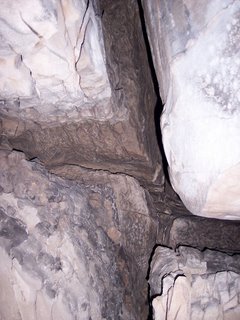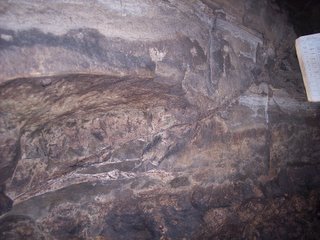Joints and faults are both fractures, but joints show no displacement of the rocks on either side, whereas faults, by definition, are planes of displacement. Both are produced by stresses such as compression, tension and torsion, any of which may act in any direction.
Joints usually occur in two forms - conjugate joints, which are usually regular in occurance and form rectangular "blocks" in the limestone; and oblique joints, which bisect or diagonal some of the conjugate blocks. Joints are partial to remaining within a single bedding plane, or at most breaking through two or three beds - this is probably why some joint-controlled cave passage doesn't show a joint at the ceiling. Joints that pass through more beds than most are called "master joints", these are good candidates to form cave passage. Cave passages that form rectangular, maze-like patterns are formed around these rectangular joints, as can be stair-step profile passages.

Ceiling shot showing joint-controlled cave formation
The key component of a fault is displacement, or shifting of one or both halves. There are several classifications based on how the displacement occurs - sliding laterally (wrench or tear faults), pushing one side down or up, or which direction - the details here are out of the scope of Armchair Speleology. Faults are usually not vertical, however, angles of 45° to 60° are common, and the displacement causes some interesting things to occur. The faultlines are typically not smooth, but rather irregular; the displacement can cause voids to line up, leading to easy cave formation along them, or to being filled with mineral deposits. With large displacement, they can cause differing beds to come into contact, with different amounts of permeability, leading to drastic change in cave direction or shape. The grinding of rock in a fault can compress and polish the surface where they meet, these smoothed surfaces are called "slickensides".

A small fault with about 6" displacement. Note how the white band in the limestone is interrupted and shifted by the diagonal fault.

An example of slickensides on the face of some breakdown
Photos from M*R Cave ©Brian Masney
No comments:
Post a Comment